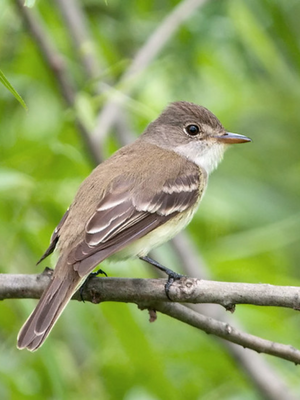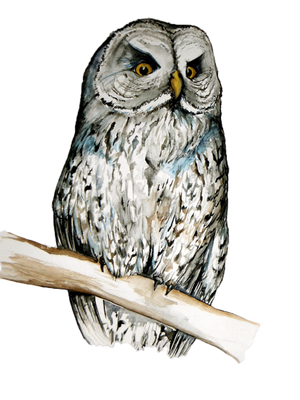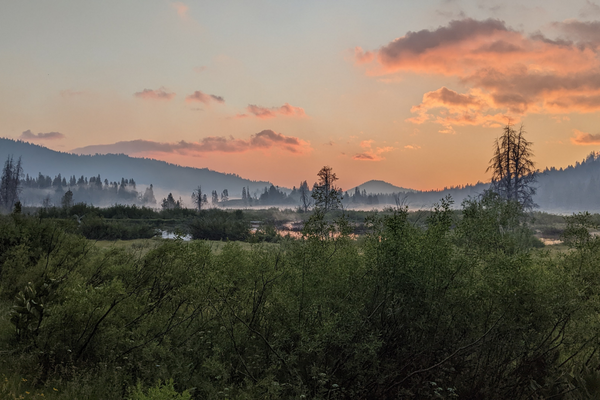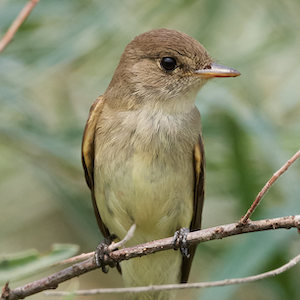As global warming is changing our world, climate scientists have developed sophisticated models to predict what the climate will be like in different places in the future. Conservation biologists and ecologists, in turn, are plugging these forecasts into different models to predict where different bird species will be able to survive decades from now- and the news for many species hasn’t been good. But climate variables, like temperature or precipitation, are just a few of many factors that determine where a given bird species can live. In a paper published last week in the journal Ecosphere, IBP Biologist Lynn Schofield along with IBP’s Meadow Bird Specialist Helen Loffland and Executive Director Rodney Siegel, compared the performance of models using only climate variables, versus models using both climate and geophysical variables, in predicting habitat availability for Willow Flycatchers (Empidonax traillii) and Great Gray Owls (Strix nebulosa) in the Sierra Nevada of California.

A Willow Flycatcher. Photo by Kelly Colgan Azar.
The researchers used Species Distribution Models (SDMs), which are kind of like crystal balls but with math instead of magic inside them. These models are widely used by biologists to predict where suitable habitat for a given species will be located in the future based on different variables. These predictions allow land managers and conservationists to protect future critical habitat now. If you’ve ever bought a plant and looked at the tag to see what USDA Plant Hardiness zone you can plant it in, you’ve used an SDM, albeit a simple one. The Plant Hardiness Zone Map is based solely on minimum temperature in a given location. So it can tell you if your plant is likely to freeze to death in the winter where you live, but that’s it. But we all know that other variables like soil type and precipitation also determine whether a plant will thrive or wither. Considering those variables at the same time helps you make a better choice about what species to plant.
But as you start adding more variables to your model, especially variables of different types (i.e. precipitation might be a continuous numerical variable and soil type is a category), and variables that interact with each other (maximum temperatures are often linked to minimum temperatures for instance), the math in your model gets a LOT more complicated. Plus, adding variables only makes your model better if they are relevant variables. And on the flip side, sometimes there are relevant variables that you just don’t have the data for. To evaluate how well a model might predict the future location of suitable habitat, scientists compare its prediction using historical data with the distribution of the species in the past. For instance, if you plugged climate data from the 1980s into your penguin distribution model and it predicted that penguins were found in Panama at that time, you’d know that your model wasn’t very good.
This study focused on two very different species using the same habitat- wet montane meadows in the Sierra Nevada. Great Gray Owls are resident birds of prey that hunt small mammals, most often in meadows, although they also sometimes hunt in other forest openings such as burned areas and clearcuts. Willow Flycatchers are insectivores and long-distance migrants, and in the Sierra Nevada they only breed in wet montane meadows.
Because these species are more or less restricted to wet meadows in the Sierra Nevada, it makes sense that geophysical variables might be relevant to their distribution because these meadows don’t occur just anywhere. There must be a stream or river, a broad, relatively flat area where stream flows can slow down and spread out, and soil types that can support appropriate vegetation. Presumably, including geophysical variables in SDMs for Willow Flycatchers and Great Gray Owls would improve their predictive ability.

A Great Gray Owl. Illustration by Lynn Schofield.
The addition of geophysical variables did improve the SDM for the Willow Flycatcher compared to the SDM using only climate variables, and both models yielded similar predictions that Willow Flycatcher habitat in the Sierra Nevada would decrease. The climate-only model predicted that suitable habitat would shift up in elevation for the flycatchers. But the model with geophysical variables, including catchment area or meadow size, showed that the flycatchers prefer larger meadows. However, meadows in the Sierra Nevada tend to be larger and more abundant at middle elevations, limiting the number of higher-elevation meadows predicted to provide good habitat in the future.
Yet in Great Gray Owls, the addition of geophysical variables did not have the same effect. In this case, the models based on climate only and climate plus geophysical variables performed equally well, but made different predictions. The climate-only model predicted the loss of nearly all the Great Gray Owl habitat in the Sierra Nevada, while the climate plus geophysical variables model predicted that suitable habitat will decline, but that much will remain within the species’ current core distribution in the western half of Yosemite National Park and adjacent areas.
The results of this Sierra Nevada specific study differ from SDM predictions made for each species on a continent-wide scale. When all Willow Flycatchers are taken as a whole, suitable habitat is expected to decline, but much more modestly than the SDM predictions for the Sierra Nevada population. Species-wide predictions for the Great Gray Owl suggest that they may lose up to 94% of their existing range by 2080, but the SDMs with geophysical characteristics in this study predict that significant habitat will remain in the Sierra Nevada. Schofield says that at first these results surprised her:
I was especially surprised, at least initially, by the fact that the Sierra Nevada populations of these two widespread species may respond to climate change in ways that are quite unlike other populations of these species in other portions of their range. In retrospect, this makes quite a bit of sense, because we know that the Great Gray Owls and Willow Flycatchers in California have unique habitat needs relative to those living in other parts of the continent. In the case of the Great Gray Owl, the Sierra Nevada owls are genetically distinct as well.
Ultimately Schofield believes that the addition of geophysical variables improves the predictive ability for species that rely on patchy habitat types like montane meadows:
Many species have habitat restrictions that go above and beyond the climate or broad-scale habitat types. Any species reliant on wetlands, lakes, rivers or other landscape features that are relatively restricted in their distribution will not be able to freely change their range in the face of changes in climate. Understanding what habitat features are important to each species will be important to understanding future conservation challenges. The dangers of climate change for species limited by patchy habitat types may be compounded, but on the other hand, it is possible that as long as these habitat types remain on the landscape these species may be more capable of taking refuge in their preferred habitat and persisting through time.
And while species-wide, range-wide SDMs provide a valuable big-picture look at how bird species will be affected by wide-scale changes like climate change, Schofield believes conservation decisions must be made using more population-specific SDMs. She elaborates:
The needs of a single species aren't the same everywhere they live and the way they respond to habitat changes will be different. Conservation needs to be tailored not only to the species, but also to the population and the habitat in question. The Sierra Nevada is a unique environment, so conservation strategies to support species communities in the Sierra Nevada will also be unique.
Ultimately, SDMs- regardless of how specific they are or what variables they include- can only make predictions and not guarantees. Predictions can help us be better prepared, but they don’t negate the need to act in the present. “It is important to continue monitoring, studying, and conserving species and ecosystems, both rare and common, as the future unfolds,” says Schofield.

Photo by Emma Cox.






